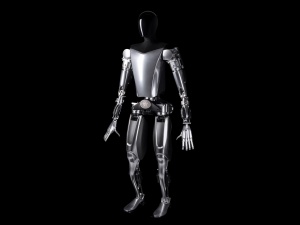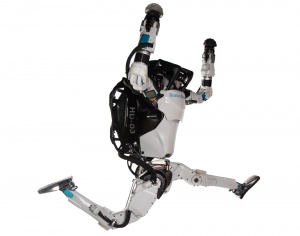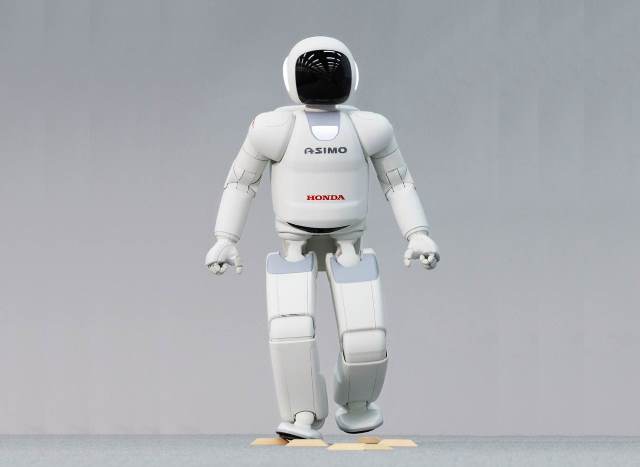Humanoid Robots
A Humanoid Robot is a robot that is designed to look like the human body. [1] According to this, a humanoid robot needs to be able to walk and move like the human body. A Bipedal Robot is a robot that has two legs that are used to walk like humans. Additionally, a humanoid bipedal robot might include other bodily features such as a head and arms. To allow the robot to interact with the world and mimic a human’s senses, it may have cameras and sensors for eyesight, speakers for speech, and microphones for hearing. Many companies have been working on developing bipedal humanoid robots, some longer than others. Tesla, Boston Dynamics, Apptronik, and Honda are some of these companies with their own versions of a bipedal humanoid robot.
Contents
Tesla Bot

Tesla Bot is a humanoid robot and the newest endeavor for Tesla. Currently, Tesla products include self-driving electric car models and solar panels for homes. Tesla Bot will build off the technology that exists in Tesla’s self-driving cars to create a “general purpose, bi-pedal, humanoid robot.” [2] Tesla's concept for Tesla Bot was announced in August 2021 at Tesla AI Day. Tesla Bot, which is currently in development, is also referred to as Optimus. The first prototype of Tesla Bot was revealed at AI Day in September 2022, about a year after its initial announcement. During a live demonstration at AI Day 2022, Tesla Bot walked around on the stage, moved its arms around, and waved to the crowd. After the live demonstration, Musk and his team used video demonstrations to show the robot walking and delivering a box to a location, watering plants with a watering can, and picking up and relocating parts in the Tesla factory. The robot’s point of view was included to show the crowd everything it could see. The objects identified by Tesla Bot were highlighted in different colors to distinguish different types. For example, the robot's arm was highlighted in blue and nearby people were highlighted in green. A second robot prototype that is more similar to Tesla’s concept and ideal end product was revealed. Since the second robot prototype was not yet ready to walk, it was propped up on a stand. The only mobility shown was moving its arms and legs for the audience.[3]
Tesla Bot weighs 161 pounds, which is 36 pounds more than the original 125 pound estimate. Tesla Bot runs on the same self-driving computer as those utilized in Tesla cars. In other words, the robot makes use of the technology that Tesla self-driving cars use to map the environment, identify hazards, and make decisions. Each of the robot’s hands have 11 degrees of freedom and 28 actuators to allow full-body movement. Additionally, Tesla has plans to use their own custom designed actuators in Tesla Bot. In terms of power efficiency, the robot’s power consumption is 100 watts sitting and 500 watts walking. Tesla Bot can walk at a speed of 5 miles per hour. The expected cost of a Tesla Bot will be less than $20,000 when Optimus is ready for purchase. The robot contains cameras, microphones, and speakers to simulate a human’s vision, hearing, and speech. Tesla’s end goal for Tesla Bot's mobility is the ability to complete 18 different movements. These movements vary in complexity and include forward walking, squatting, side stepping, turning while walking, and climbing stairs. Having more movements increases agility and allows the robot to more efficiently mimic a human and better interact with its environment.[4]
Boston Dynamics Atlas

Boston Dynamics is a robotics company with three different versions of robots. Spot and Stretch are robots that can do specialized tasks and are available for purchase. [6] Atlas is Boston Dynamic's humanoid robot, which is a research project. Since its reveal in 2013, Atlas has seen some major improvements. Atlas can travel 2.5 meters per second, stands at a height of 1.5 meters, and weighs 89 kilograms. [5] Atlas has a color camera and a Lidar module to simulate vision.
In a demonstration on Youtube, Atlas shows its different movements: walking, running, jumping, and even doing backflips. In addition, Atlas demonstrates carrying and moving different objects in the video. The robot completed this task in numerous movements: squatting to pick up an object, placing an object, traveling with an object, throwing an object, and pushing an object.[7] Boston Dynamics has a simulator for Atlas that allows engineers to try new instructions on their robot without the physical robot attempting it. Boston Dynamics even has publicly available videos of Atlas not performing as expected. [8] With this, you can see part of the reality of developing and testing a humanoid robot. Additionally, it shows that these bipedal robots don’t act as expected or hoped for all the time. Atlas is not available for purchase, unlike Boston Dynamics' other robot models.
Honda ASIMO and E2-DR

Honda’s first bipedal robot was created in 1986 and was called E0. E0 successfully walked on its two legs, but it was not very advanced or human-like. [10] In 2000, Honda unveiled the first version of ASIMO. Honda continued improving ASIMO’s capabilities up until 2011. ASIMO is 130cm tall, weighs 48 kilograms, and has a maximum speed of 9 kilometers per hour. These specifications changed over time since the earliest ASIMO version. Similar to other bipedal robots, ASIMO utilizes sensors to simulate human senses. ASIMO uses input from the sensors to make behavioral decisions. Honda has videos to show ASIMO responding to its environment in different ways. Some of its capabilities are walking and avoiding nearby people, walking on uneven ground, kicking a ball, and pouring a drink. In 2018, Honda announced their decision to stop development of ASIMO to pursue other projects. [11] One of those projects is the development of another humanoid robot, E2-DR. [9]
Honda’s E2-DR is a robot designed for the purpose of disaster response. E2-DR is capable of both bipedal and quadrupedal walking, meaning it walks on its two legs or both its arms and legs. E2-DR is 1.68 meters tall and weighs 85 kilograms. E2-DR has 33 degrees of freedom: eight for each arm, six for each leg, two for the torso, and one for the hands and head. Bipedal walking speed for E2-DR is 4 kilometers per hour and quadrupedal walking speed is 2.3 kilometers per hour. Some of its accomplished movements include stepping over objects, moving between ladders and the floor, climbing up stairs, and moving through doors and walkways. There are certain conditions that it needs to handle to successfully complete disaster response work. As a result, E2-DR is dustproof, splashproof, and can operate at temperatures between -10 and 40 degrees Celsius. [12]
Apptronik Astra and Apollo
Apptronik is a Texas-based robotics company. Apptronik developed a robot called Astra featuring only upper-body movement capabilities. Astra is not a bipedal robot, since it doesn’t walk on two legs. However, it has some human-like features such as a head and arms. Apptronik created a prototype of a full-body humanoid robot, called Quick Development Humanoid or QDH. Apptronik is now building off Astra and QDH to create a humanoid robot called Apollo. Apollo will stand at a height of 1.75 meters, weigh 75 kilograms, and will be able to lift 25 kilograms. Apptronik’s plan is to create their own actuators for Apollo. Apptronik is still working on the concept for Apollo and has plans to present it in March 2023. [13]
Ethical Concerns
A future with humanoid robots raises a variety of ethical concerns. There are a variety of orphan risks for this type of technology. Orphan risks are "risks that are hard to quantify and easy to overlook." [14] Bipedal humanoid robots are still in development at this point in time and there is a lot of uncertainty regarding a future with such robots. Some potential concerns include data collection, human-robot interaction, job loss, safety, design errors, and legal issues.
Data Collection
As evident in the demonstration of Tesla Bot, these robots need to collect data to move around and interact with their environment. Data collected by robots could include input from cameras, speakers, and microphones. There is concern regarding use and storage of information collected by the robots, especially if it’s classified as private or sensitive information. Similar to other technologies, the robot will use and store certain information which is then susceptible to data breaches.
Safety
Walking and balancing on two legs has proven to be a challenge for bipedal humanoid robots, especially on uneven ground. Although they may show huge success walking and completing challenging movements, mistakes can happen. One concern is a robot falling on a person or an object. Although their weights fall within a normal range for a human, they are made out of materials including metal and could cause damage to objects or injury to people. In a demonstration of Boston Dynamics’ Atlas robot, a person prompted the robot to get his tools. When the robot got closer to the person, it threw the tool bag to them. This demonstration happened in a controlled environment, but it sheds light on the danger of letting a robot freely interact with people. Another safety risk is psychological effect on humans from engaging with robots. The humanoid robots in development are being designed to interact and coexist with people. It’s unknown and difficult to predict how humans will react to robots, especially those that resemble the human body. The robot’s appearance is one of the factors that might affect how a human responds to it. The concept is fascinating to many people, but that doesn't mean that a humanoid robot will always be received well. Current humanoid robots vary in how realistic and human-like they are. The nature of these interactions varies as well. Robots with microphones and speakers to communicate with people adds an extra dimension to human-robot interaction. Robots that provide a service is an instance of a social interaction. Non-social interactions between humans and robots could be walking next to or past each other.
Unemployment
Another common concern of robots is mass unemployment due to the replacement of people for robots in certain jobs. The idea of a humanoid robot that can move and complete tasks like humans, makes replacement by robots seem even more likely. Some fear that robots will take jobs away from humans, although others believe that humanoid robots will work alongside humans and even bring new jobs.
It's estimated that 85 million jobs will be replaced by robots by 2025, but 97 million jobs will open due to the same reason. [15] As a result, the addition of robots to the workforce will bring an estimated 12 million additional jobs than before.
A common motivation for the design of humanoid robots is to do jobs that are dangerous or unattractive to humans. For example, E2-DR, the disaster response robot would be beneficial in situations where conditions may be unsafe for a human.
Design Errors
Since humans are designing and building these robots, there is the factor of human error to account for. Bugs in the software could cause the robot to behave in an unexpected manner or not know how to respond in a situation. Additionally, biases from humans could be unintentionally coded into the software for these humanoid robots.
Security
Like other modern technologies, it's possible that humanoid robots could be susceptible to hacking and cyberattacks. The result of this might be losing control over the robot or the data stored by it.
Comparison of Atlas and Optimus
Boston Dynamics has a more advanced, working prototype of a humanoid robot than Tesla. Atlas moves gracefully and currently has a wide array of movements and skills. Additionally, there is more information and video demonstrations of Atlas in action than Optimus. Both robots fall short in some categories including battery life, autonomy, mobility, and intelligence.
Atlas can only complete brief demonstrations due to it's limited battery life. However, Atlas has demonstrated impressive mobility capabilities. In Atlas' demonstrations, the robot follows routines given by its creators. At this point in time, Atlas doesn't have the ability to freely make decisions on its own.
Optimus can allegedly run for a whole day of work, although this has not been proven by Tesla so far. Although Optimus has the ability to do certain tasks, it's unclear in the demonstrations at Tesla AI Day 2022 how Optimus is receiving instructions and the extent of autonomous abilities. The first Optimus prototype showed off forward walking, turning, and arm movement, but the robot doesn't appear to be close to the mobility that Tesla plans to develop. The second Optimus prototype was unable to walk at all. In terms of its intelligence, Optimus can recognize surrounding objects and people, thanks to the technology developed for Tesla's self-driving cars. In one of the video demonstrations from Tesla AI Day 2022, Optimus seems to be able to navigate its environment on its own.
Future of Humanoid Robots
Humanoid robots have an attractive market in the future, so companies are competing to make this a reality. The plan for Boston Dynamics' Atlas robot is to be used for research, whereas Tesla's Optimus is being designed for mass production. How soon humanoid robots could appear in work settings or roam freely can only be roughly estimated at this point in time. Current humanoid robot have certain limitations that require more development and innovation from their creators.
References
- ↑ Wikimedia Foundation. (2023, January 29). Humanoid robot. Wikipedia. Retrieved February 11, 2023, from https://en.wikipedia.org/wiki/Humanoid_robot
- ↑ 2.0 2.1 AI. Tesla. (n.d.). Retrieved January 27, 2023, from https://www.tesla.com/AI
- ↑ Tesla Ai Day 2022. (2022). Youtube. Retrieved January 27, 2022, from https://www.youtube.com/watch?v=ODSJsviD_SU.
- ↑ Koetsier, J. (2022, October 1). Tesla bot Optimus: Everything we know so far. Forbes. Retrieved January 27, 2023, from https://www.forbes.com/sites/johnkoetsier/2022/10/01/tesla-bot-optimus-everything-we-know-so-far/?sh=2cff7e6217bb
- ↑ 5.0 5.1 Atlas™. Boston Dynamics. (n.d.). Retrieved January 27, 2023, from https://www.bostondynamics.com/atlas
- ↑ Products. Boston Dynamics. (n.d.). Retrieved February 11, 2023, from https://www.bostondynamics.com/products
- ↑ Atlas Gets a Grip. (2023). Youtube. Retrieved January 27, 2023, from https://www.youtube.com/watch?v=-e1_QhJ1EhQ.
- ↑ Amadeo, R. (2023, January 19). Boston Dynamics' Atlas robot grows a set of hands, attempts construction work. Ars Technica. Retrieved January 27, 2023, from https://arstechnica.com/gadgets/2023/01/boston-dynamics-atlas-robot-grows-a-set-of-hands-attempts-construction-work/
- ↑ 9.0 9.1 Honda global: Asimo. Honda Global | ASIMO. (n.d.). Retrieved February 11, 2023, from https://global.honda/innovation/robotics/ASIMO.html
- ↑ Honda Global: Robot Development history. Honda Global | robot development history. (n.d.). Retrieved February 11, 2023, from https://global.honda/innovation/robotics/robot-development-history.html
- ↑ Wikimedia Foundation. (2022, November 6). Asimo. Wikipedia. Retrieved February 11, 2023, from https://en.wikipedia.org/wiki/ASIMO
- ↑ Ackerman, E. (2023, January 10). Honda unveils prototype E2-DR Disaster Response Robot. IEEE Spectrum. Retrieved February 11, 2023, from https://spectrum.ieee.org/iros-2017-honda-unveils-prototype-e2dr-disaster-response-robot
- ↑ Ackerman, E. (2023, January 27). Apptronik developing general purpose humanoid robot. IEEE Spectrum. Retrieved January 27, 2023, from https://spectrum.ieee.org/humanoid-robot-apptronik-apollo
- ↑ Maynard, A. (2021, September 7). Elon Musk's Tesla bot raises serious concerns – but probably not the ones you think. The Conversation. Retrieved January 27, 2023, from https://theconversation.com/elon-musks-tesla-bot-raises-serious-concerns-but-probably-not-the-ones-you-think-166714
- ↑ Orduña, N. (2021, March 19). Why robots won't steal your job. Harvard Business Review. Retrieved February 10, 2023, from https://hbr.org/2021/03/why-robots-wont-steal-your-job